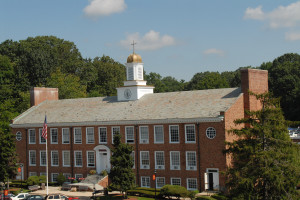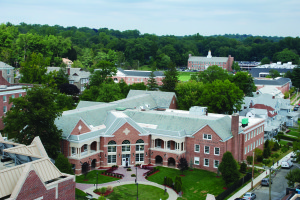Iona College has approved a new campus master plan, a guiding document that outlines development projects that would serve to change the face of North Avenue, the New Rochelle thoroughfare that”™s inherently an extension of the campus.
The plan, approved by the college”™s board of trustees last month, includes five multimillion-dollar projects ”“ four on-campus renovation and construction proposals and one blueprint for a residence hall on North Avenue.
The four campus projects include building a 54,000-square-foot business school with a trading floor and business incubator space; a new performing arts center with a multipurpose rehearsal space and performance halls; a renovated science center to house new teaching and research laboratories; and an expanded athletics arena to accommodate a sports medicine facility and apparel stores.

The college proposes developing a seven-story commercial and residential building on North Avenue, housing up to 350 students on six floors and leasing the street-level storefront space to college-related businesses such as bookstores and restaurants.
The dorm has long been a talking point in the community and the latest proposal represents a pared-down project after Iona faced community opposition when seeking to build a 10-story dormitory on the avenue a few years ago. The college voluntarily withdrew its application for that proposal and said it would work more closely with city government on its redevelopment plans.
The city changed the corridor”™s zoning last July to accommodate college-use developments. Since then, Iona bought Cannone”™s Pizza and Campus Wings in November and the Mirage Diner last month.
“We went through a process that involved the community and took a fresh look at the Iona area,” said Luiz Aragon, New Rochelle”™s commissioner of development. “The big focus of our study looked at dormitory use, so we rezoned North Avenue to accommodate higher density developments along the corridor, and we”™re excited about the proposal and happy to proceed within the zoning parameter.”
The Mirage Diner site at 690 North Ave. is where the college wants to build the residence hall. When the college bought the eatery and its adjacent parking lot, the agreement was to keep the diner open and operating with the existing lease, while the college pays real estate taxes on the property, said Anne Marie Schettini-Lynch, Iona”™s senior vice president for finance and administration. The college will also pay real estate taxes on Cannone”™s Pizza and Campus Wings, but there are no set plans for how to develop that property yet.

Six years ago, the city spearheaded a North Avenue corridor study to revitalize the commercial district. Through Iona”™s proposal to build a mixed-use residential and commercial space, the city is hoping to spark an area that has been struggling for an identity in recent years.
“Iona is one of the anchors of the local economy as well as an engine of cultural activity and employment,” Mayor Noam Bramson said. “Both the city and institution have overlapping interests.”
The area outside of the college campus was known as “The Strip” and was a nighttime destination filled with bars and small clubs. But with increasing enforcement of the legal drinking age starting in the 1990s, paired with the emergence of a White Plains nightlife, many of the establishments shut down, leaving holes in the business corridor.
The next step for Iona is to complete architectural plans and a feasibility review for the projects, which the board said was covered by a funding allocation. The planning and reviewing process could take anywhere from six to 12 months.
The residence hall and commercial-use structure will be funded through financing such as bonds and mortgages, while the other four projects will be funded by donations, said Paul Sutera, Iona”™s senior vice president of advancement and external affairs.
This year, the college is launching the largest capital campaign in Iona”™s history to raise funds for the four on-campus projects. Sutera said half of the college”™s fundraising money will be used as capital for brick-and-mortar projects and half will be used for endowed scholarships and professorships. There”™s no fundraising goal for the seven-year campaign, but the college plans to exceed the $82 million mark from its last campaign.
“If we only raised $82 million, and $40 million went to the projects, we wouldn”™t be able to get all the buildings done,” Sutera said. “If we raised $200 million, and $100 million went to the projects, now that would make more sense.”


















